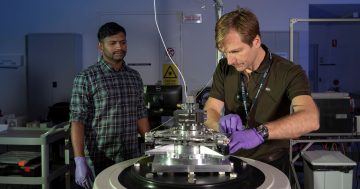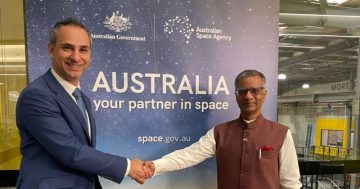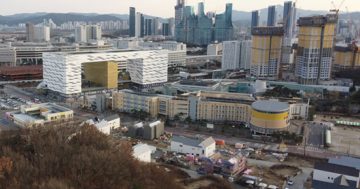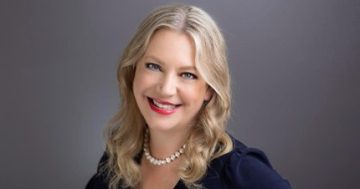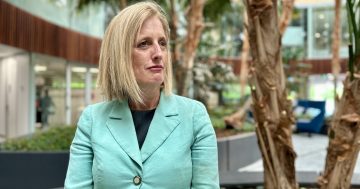Space is herebut women are not getting their place in it say Elise Stephenson, Naomi Hartanto, Kareena Dhillon, Sarah Furman and Isabella Vacaflores.
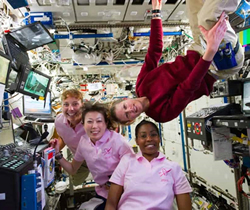 “This isn’t just about exporting existing structures and systems into outer space, but new possibilities and new futures for all”.
“This isn’t just about exporting existing structures and systems into outer space, but new possibilities and new futures for all”.
When asked why diversity in the space sector matters, this answer summed up the key message at Australia’s Diversity at the Frontier: Gender Equality in Space Conference held in April this year.
There is a misperception that the space sector is a niche field concerned primarily with rocket launches and astronauts and not deeply grounded in what we do here on Earth. In reality, space and space technologies are everywhere.
From the use of satellites for communications, GPS technology, the internet, business transactions and even climate monitoring, to space innovations converted for earthly purposes such as artificial limbs, memory foam and PCs, we all interact with space and use space technologies on a daily basis.
What, then, is the role of diversity in space?
The data is clear. Women represent only one in five space sector workers, and almost 90% of all astronauts have been men.
Even though women have demonstrated biological and psychological advantages when it comes to space travel, they remain side-lined. What’s more, the false narrative that working in the space sector requires a background in STEM discourages employees from more female-dominated humanities and non-STEM industries from even considering a career in space.
The challenges faced by other historically excluded groups are duplicated, with those from First Nations, culturally and linguistically diverse, lower socio-economic status and gender and sexual minority backgrounds even more underrepresented in the sector.
Yet, diversity matters because space missions and space technologies are expensive and entail risks that we cannot fully comprehend. Quality decision-making is critical to the longevity of both the sector and humankind, but this is not possible without a ‘gendered’ lens or inclusion of diverse perspectives.
In 2019, NASA had to cancel its all-female spacewalk due to a shortage of spacesuits on board to fit women. If a leading space organisation like NASA – which has a range of diverse programs aimed at improving representation of historically underrepresented groups – struggled with something as simple as uniforms and equipment for their female astronauts, what else is being overlooked?
A future with more historically excluded groups in the picture looks infinitely brighter. After all, it seems unlikely that, had more women been involved in planning the failed spacewalk, the same critical gaffe would have occurred. We know from research in space and adjacent industries that diversity results in more innovative and inclusive teams, increases productivity, and reduces groupthink.
Sending more women and historically excluded people to space or part of the sector expands our understandings of how space affects diverse bodies and allows for the development of space technologies and their potential applications across myriad contexts on Earth.
So, what can we do to advocate for diversity, belonging, inclusion and equity in the space sector?
At the heart of the Conference lay a recognition that, to change humanity’s trajectory in space, rectify past imbalances, and maximise the benefits of space and space technologies, a more diverse workforce and approach to space is crucial.
The Diversity at the Frontier: Gender Equality in Space Conference was held in April 2023, convened by Dr Elise Stephenson, Dr Cassandra Steer and Prof Meredith Nash, and hosted by the Global Institute for Women’s Leadership (GIWL) and ANU InSpace. This breakthrough conference brought together experts and practitioners, policymakers, and the next generation of the space workforce to ask the hard-hitting questions and to reinforce the critical gaps for marginalised groups and individuals in the space sector.
Covering everything from the problematic language surrounding the space sector (space is often talked about being for all “mankind” rather than “humankind” and “colonising” is common language when talking about “settling” new planets), to historically excluded groups’ experiences in the sector, the conference looked to industry and government to pave the way forward.
While some initiatives have begun to address pockets of inequality, like women in space initiatives, mentoring and leadership programs, an intersectional approach is crucial to recognize the cross-cutting ways in which gender, sexuality, culture, ethnicity and other human demographic factors impact on those in the space sector.
Pluralising the workforce will lead to significant gains and mitigate major risks to the future viability of the space industry such as stifled innovation, poor staff attraction and retention, and reputational damage.
Research undertaken at the Conference highlighted that employees in Australia’s space sector see leadership as the number one priority for diversity, belonging, inclusion, and equity in the sector, whilst the ‘lack of political will to enact change’ is seen as the biggest barrier to overcoming diversity issues.
This presents tangible opportunities for the sector to make a difference and there is no time like the present for individual organisations to lead by example. Those who are quickest to embody diversity and inclusion (D&I) will likely have the best access to talent and obtain tremendous advantages.
That said, there are still many inevitable challenges left unsolved in this field – including pockets of resistance and backlash. Further research, plus policy development, is needed, particularly to support the large contingent of small and medium sized enterprises in the space sector which lack the resources to do this themselves. Key recommendations from the
Conference included the need for:
- More research on representation and experiences of diversity in the space sector.
- Leadership commitments, policy development and practical changes in the space industry to support historically excluded groups’ participation and experiences.
- Formal and informal strategies, ranging from equitable parental policies, leave policies, promotions/hiring policies, to the support of informal networks.
- Funding, procurement and sponsorship assessment criteria across the sector that prioritises action on D&I and recognises demonstrable improvements on a regular basis.
Australia’s emerging space security institutions and rapidly growing industry provide an unprecedented opportunity to influence the future direction of the sector. ‘Now’ matters, as we have the best chance to embed diversity and equality from the ground up.
Read the full Diversity at the Frontier: Gender Equality in Space Conference insights at this PS News link.
Written by Elise Stephenson , Naomi Hartanto, Kareena Dhillon, Sarah Furman and Isabella Vacaflores.
This article first appeared in Broadagenda



